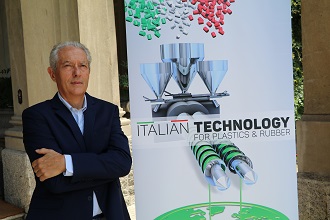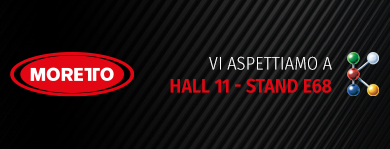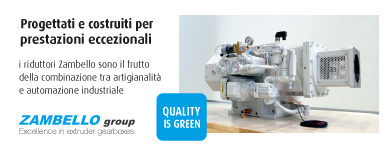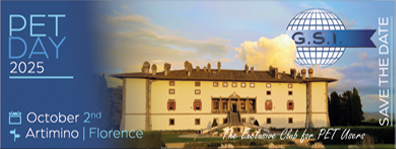
Once again, the mid-year figures show a drop in Italy’s imports and exports of plastic and rubber machinery, though the reduction is less marked than for previous months. In fact, in comparison with the first six months of 2018, imports for the period January-June 2019 showed a drop of about 17% (with respect to the figure of -20% in March), while exports slowed down by about 5% (-8% in March). As a result, the positive balance of trade showed improvement, though minimal. This in summary is the situation revealed by the Amaplast Studies Center in its analysis of the foreign trade statistics published by Istat.
An important factor shown by the statistics is the contraction in trade with Italy’s principal and historic business partner, namely Germany: the supply of Italian-built plant to German pro-cessing companies suffered a 26% slump, and the purchase of German technology by Italian companies fell by a third. In actual fact, this comes as no surprise, as it is an accurate reflection of Germany’s economic slowdown, and in particular that of its industrial sector.
Moreover, exports by our German competitors also shrank. Even before the publication of official mid-year statistics, the respective trade association had revised the figures for 2018 and forecasts for 2019, announcing that it expected a 10% reduction in turnover, caused primarily by the crisis in the automotive sector and the difficulties linked to plastic’s public image. Italian companies are having to come to terms with the same situation.
Overall, over the first six months of 2019, Italian processing companies imported less machinery from their major European suppliers - Germany, Austria, France and Switzerland - to the benefit of Asian suppliers, above all China, and Japan though to a lesser degree in terms of total value.
As mentioned above, exports revealed a reduction in overall value, but an improvement for some specific export categories, with respect to previous months. For example, exports of flexographic printing machines and extruders returned to growth, and the drop in the exports of machinery for foamed products was less marked.
From a geographical point of view, considering market macro-areas, the statistics provided by Istat revealed that Europe, which remains by far the largest export market, showed a drop in market share, as a result of an approximately 9% shrink in overall value. The latter was caused principally by reduced sales in markets outside the EU, more specifically with a dramatic reduction for Turkey (-37%) though with a slight improvement for Russia (+2%).
 The Nafta area remains the second-largest export market, though with results less encouraging (+1%) with respect to last year, reflecting the decrease in exports to Mexico (-12%) and Canada (-39%), while sales to the United States continued to grow (+15%). Overall, exports to South America have decreased (-6%), even though the most important markets are showing signs of recovery: +5% for Brazil, +18% for Argentina and +12% for Colombia.
The Nafta area remains the second-largest export market, though with results less encouraging (+1%) with respect to last year, reflecting the decrease in exports to Mexico (-12%) and Canada (-39%), while sales to the United States continued to grow (+15%). Overall, exports to South America have decreased (-6%), even though the most important markets are showing signs of recovery: +5% for Brazil, +18% for Argentina and +12% for Colombia.
Exports to the Asian market show a return to stronger growth (+10% overall). Considering just the most important markets in terms of overall value, there was good progress for the Far East area as a result of increased exports to China (+39%), Thailand (+55%) and Indonesia (+110%), while India showed a slight reduction (-1%). On the other hand, the flow towards the Middle East revealed a slight weakening (-1%), reflecting the collapse in exports to Iran (-83%, with sales approaching zero) and slowing trade with the United Arab Emirates (-12%), factors that were too large to be compensated by the increase in exports to Saudi Arabia (+15%) and Israel (+94%), and the exceptional growth in sales to Qatar (+244%).
There was an overall decrease in exports towards the African continent, reflecting lower demand both from Mediterranean Africa (-26% on average) and from sub-Saharan countries (-13%). The more distant destinations of Oceania (+27%) showed an improvement, with increased sales - though relatively small in overall value - to the most important export markets, Australia and New Zealand.
In a context of instability, negatively affected by the all-too-familiar climate of political and economic turbulence, the views that Amaplast collected after the summer break from companies operating in this sector revealed a less than optimistic outlook. Overall, there is concern for the tendency towards a postponement or reduction in orders by customers.
“Current market conditions are not encouraging”, declared Dario Previero, president of Amaplast, “but the companies in the sector have great hopes for the next important event for the sector: the trade fair K, to be held at Düsseldorf from October 16 to 23, where there will be many Italian exporters”.
“The event’s international standing”, continued Dario Previero, “will enable companies to meet consolidated clients and potential new customers from all over the world in order to present the latest technological innovations that they have developed - state-of-the-art equipment in terms of performance, energy consumption and above all sustainability - that could be of fundamental importance in attaining the objectives of the framework being developed in light of the move to-wards the Circular Economy”.
Italy is the second-largest exhibiting nation at the show, behind just the host country, with almost 400 companies of which about 330 are machinery and plant manufacturers.
Amaplast, which has implemented a powerful campaign in support of Italian exhibitors, will be present at K with an institutional stand (A56 in the hall 16) providing information on its industrial sector, distributing the magazine MacPlas and providing advance information on the show Plast 2021 (Milan, May 4-7, 2021), for which organizational and promotional activities will move into top gear after the show in Germany.
In addition, Lady Be, an international pop artist who makes artworks using just recycled plastic objects, will be present at the association’s stand from October 16 to 19. She will be exhibiting her works and will present a live performance with a piece dedicated specially to the event. The objective is to increase visitors’ awareness of the importance of recycling and environmental sustainability.
























